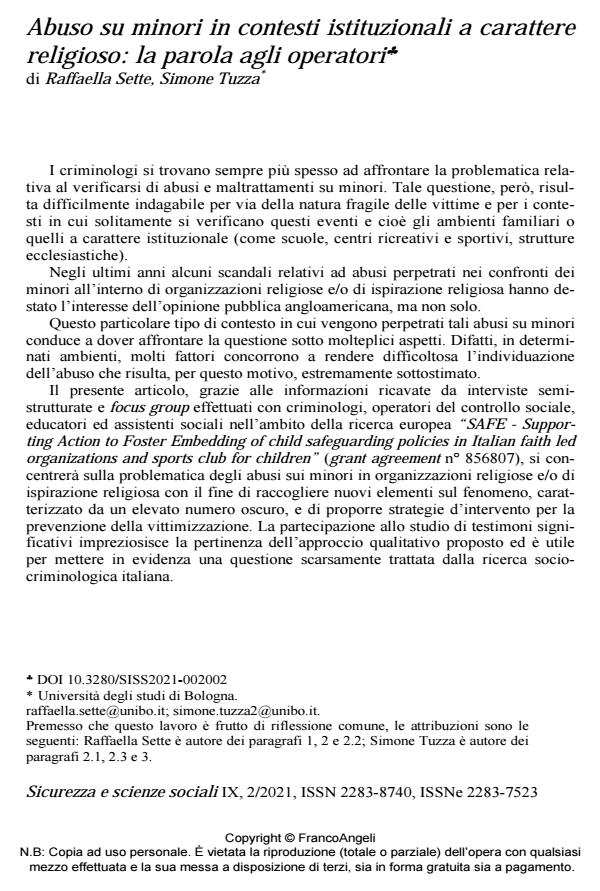Child abuse in faith-led institutional contexts of religious nature: the practi-tioners’ perspective
Journal title SICUREZZA E SCIENZE SOCIALI
Author/s Raffaella Sette, Simone Tuzza
Publishing Year 2021 Issue 2021/2
Language Italian Pages 17 P. 15-31 File size 180 KB
DOI 10.3280/SISS2021-002002
DOI is like a bar code for intellectual property: to have more infomation
click here
Below, you can see the article first page
If you want to buy this article in PDF format, you can do it, following the instructions to buy download credits

FrancoAngeli is member of Publishers International Linking Association, Inc (PILA), a not-for-profit association which run the CrossRef service enabling links to and from online scholarly content.
Criminologists increasingly address the problem of child abuse. However, this issue is difficult to explore because of both the vulnerability of the victims and the characteristics of the contexts in which these events usually occur, namely abusive families or institutional contexts (such as schools, recreational and sports centres, ecclesiastical structures). In recent years, some scandals regarding child abuse perpetrated within faith led organisations caught the attention of not only the Anglo-American public. This particular context where child abuse takes place means that this issue should be addressed in many respects. In fact, in specific environments, many fac-tors contribute to making the identification of the abuse difficult which is, for that reason, considerably underreported. Through information obtained from semi-structured interviews and focus groups carried out with some criminologists, social control operators, educators and social workers within the European research project SAFE - Supporting Ac-tion to Foster Embedding of child safeguarding policies in Italian faith-led organi-sations and sports clubs for children" (grant agreement n° 856807), this article will focus on the issue of child abuse in religious and/or faith led organisations with the aim of gathering new elements on the phenomenon, which is characterised by a high dark number, and proposing some intervention strategies to prevent victimisa-tion. The participation of experts and practitioners in the study affirms the rele-vance of the qualitative approach proposed and important to highlight an issue poorly discussed in Italian socio-criminological research.
Keywords: Abuse, minors, faith led organisations, qualitative research, prevention
Raffaella Sette, Simone Tuzza, Abuso su minori in contesti istituzionali a carattere religioso: la parola agli operatori in "SICUREZZA E SCIENZE SOCIALI" 2/2021, pp 15-31, DOI: 10.3280/SISS2021-002002